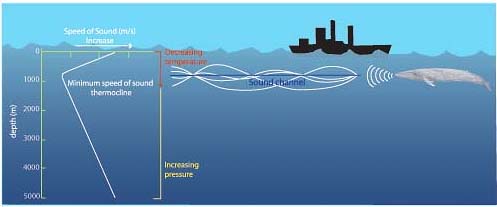This "channeling" of sound occurs because of the properties of sound and the temperature and pressure differences at different depths in the ocean. The ocean is divided into horizontal layers in which the speed of sound is greatly influenced by temperature in the upper layers and by pressure in the deeper layers. As temperature decreases, the speed of sound decreases, and as pressure (depth) increases, the speed of sound increases. Sound waves bend, or refract, towards the area of minimum sound speed. Therefore, a sound wave traveling through a thermocline (a region of rapid change in temperature with depth) tends to bend downward as the speed of sound decreases with decreasing water temperature, but then is refracted back upward as the speed of sound increases with increasing depth and pressure. This up-down-up-down bending of low-frequency sound waves allows the sound to travel many thousands of meters without the signal losing significant energy. The depth of this “channel” varies in different oceans depending on the salinity, the temperature, and depth of the water. At low and middle latitudes, the SOFAR channel axis lies between 600-1200 m below the sea surface. It is deepest in the subtropics and comes to the surface in high latitudes, where the sound propagates in the surface layer. Scientists often take advantage of the properties of the SOFAR channel. We have learned that by placing hydrophones at just the right depth (that is, at the axis of the sound channel) we are able to record sounds such as whale calls, earthquakes and man-made noise that occur many kilometers from the hydrophone. As a matter of fact, sometimes we can hear low-frequency sounds across entire ocean basins!. Image courtesy of Sounds in the Sea 2001, NOAA/OER.
NOTICE: This page is being retained for reference purposes only and is no longer being updated or maintained.


